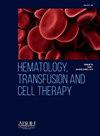BRAIN-TO-LIVER RATIO FROM 18F-FDG-PET/CT AS A PROGNOSTIC MARKER IN MULTIPLE MYELOMA
IF 1.8
Q3 HEMATOLOGY
引用次数: 0
Abstract
Introduction/Justification
18F-FDG PET/CT imaging is widely used in oncology for staging and monitoring treatment response in multiple myeloma (MM). Studies have shown reduced 18F-FDG uptake in the brains of patients with disseminated malignancies, such as malignant lymphoma and other aggressive cancers. This phenomenon is likely associated with the Warburg effect and hyperlactatemia.
Objectives
This study aimed to evaluate whether the brain-to-liver ratio (BLR) of 18F-FDG uptake in MM patients serves as a prognostic marker.
Materials and Methods
A total of 82 MM patients diagnosed between March 2011 and May 2019 were included, with a median follow-up of 25 months (range: 0.1–113). All patients underwent whole-body 18F-FDG PET/CT at diagnosis after fasting for at least six hours and with peripheral blood glucose levels below 180 mg/dL. A dose of 0.1 mCi/kg of 18F-FDG was intravenously administered 60 minutes before image acquisition. Brain and liver standardized uptake values (SUVmean) were determined using automated whole-brain segmentation and a spherical volume of interest (VOI) in the liver. The BLR was calculated by dividing the brain SUVmean by the liver SUVmean for each patient. Descriptive and bivariate analyses were performed. Overall survival (OS) and progression-free survival (PFS) were estimated using the Kaplan-Meier method and compared with the log-rank test (IBM-SPSS v.24). The follow-up data were updated in January 2025.
Results
The cohort included 55% male patients, with a median age of 64 years (range: 39–87). At diagnosis, 67% had ISS stage III disease, 16% had an ECOG performance status ≥ 2, and 88% presented with bone lesions. Chemotherapy was administered to 94% of patients, with 27% receiving bortezomib. A complete response (CR), very good partial response (VGPR), or partial response (PR) was achieved by 71% of patients. Disease progression occurred in 47% of cases, and the overall mortality rate was 69%. The 60-month OS and PFS rates were 35% and 10%, respectively. The BLR was significantly correlated with sex (R= 32%, P= 0.006), overweight status (R = 32%, P =0.007), ISS stage (R = 23%, P = 0.04), and beta-2 microglobulin levels (R = 42%, P < 0.0001). Patients with a median BLR >2.7 had significantly better OS (50% vs. 13%, P= 0.006) and PFS (3% vs. 0%, P = 0.006).
Conclusion
BLR derived from 18F-FDG-PET/CT at diagnosis appears to be a strong prognostic indicator of OS and PFS in MM patients, with a cut-off value of 2.7. BLR also correlates with beta-2 microglobulin, a well-established serum marker of tumor burden, and ISS stage III disease. The lower 18F-FDG uptake in more aggressive MM cases may be associated with neoplastic lactate production. Given that brain cells can utilize lactate as an alternative energy source when blood lactate levels rise, this may result in reduced brain FDG uptake. Consequently, BLR may serve as a marker of high glycolytic MM burden and provide an estimate of disease severity.
求助全文
约1分钟内获得全文
求助全文
来源期刊

Hematology, Transfusion and Cell Therapy
Multiple-
CiteScore
2.40
自引率
4.80%
发文量
1419
审稿时长
30 weeks
 求助内容:
求助内容: 应助结果提醒方式:
应助结果提醒方式:


